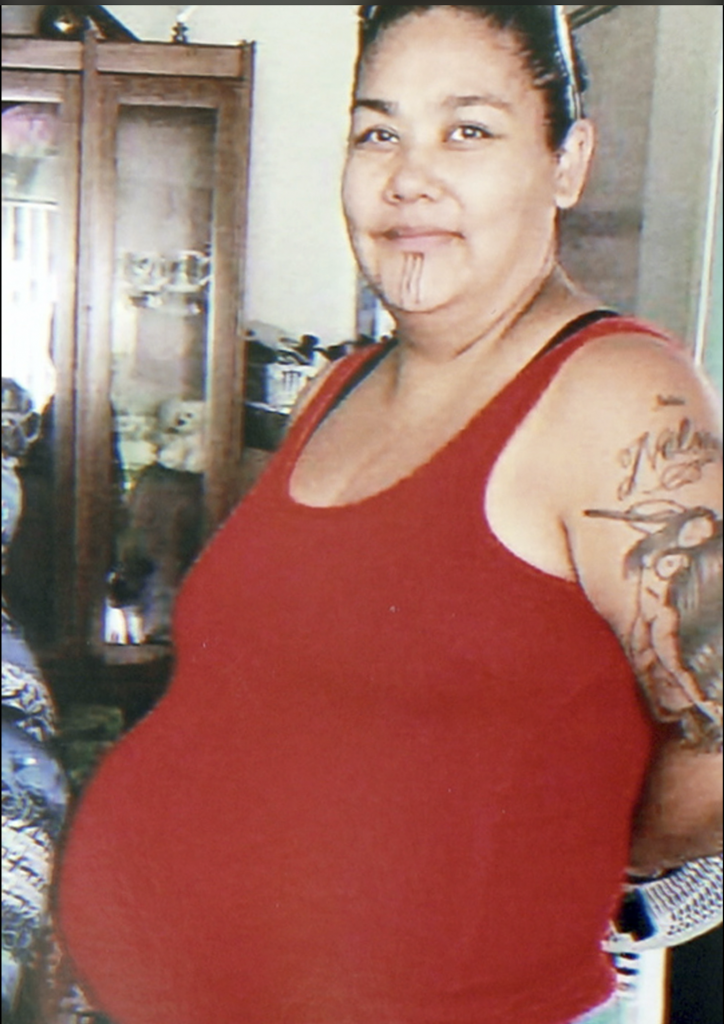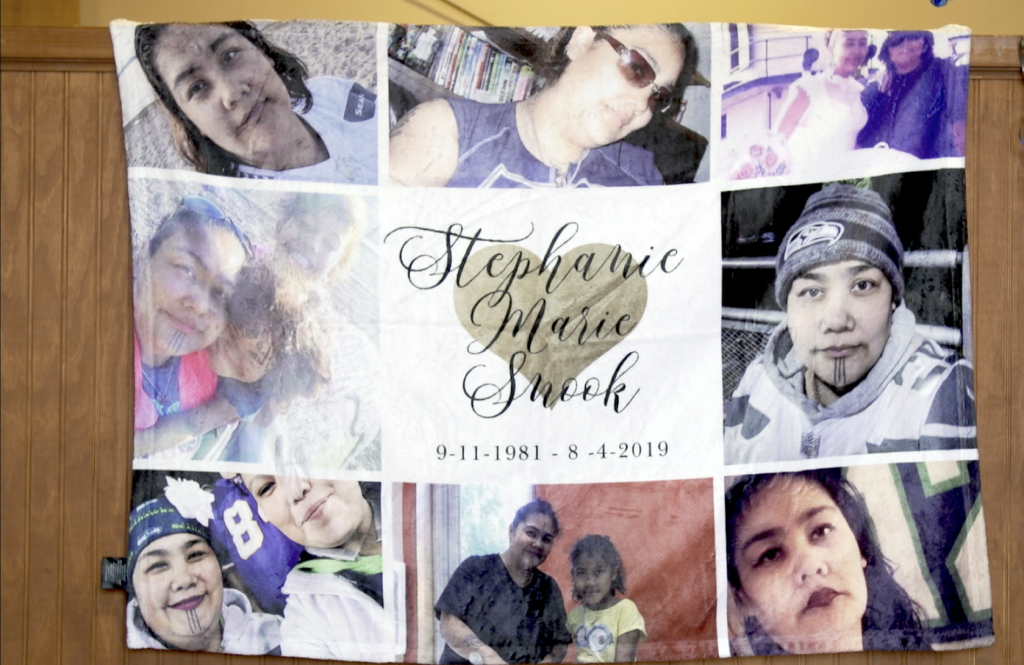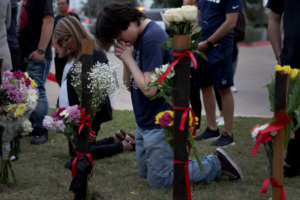Stephanie Snook, who was due with twins, wanted to be interviewed for an article about her race’s high rate of pregnancy-related deaths. She had no idea her own life was at stake.
by Elizabeth Chuck and Haimy Assefa | NBC NEWS
SEATTLE — The twins were scheduled to be delivered on Aug. 21, 2019, and Stephanie Snook was nervous.
Her pregnancy had not been planned. Snook was born with a heart condition; after her first two children, she had been told getting pregnant again could put too much stress on her heart.
Nonetheless, Snook, 37, a warehouse clerk in food services at the Seattle Mariners’ ballpark, trusted she was in good hands.
A member of the Tsimshian and Tlingit tribes of Alaska, she had been going to a community health clinic that primarily caters to Native populations near her Seattle home. Once she found out she was having twins, she switched to a high-risk maternal-fetal specialist at Seattle’s Swedish hospital system.

Snook had just begun her third trimester when NBC News contacted her for an article about maternal mortality, the deaths of women from pregnancy-related causes. Across the country, American Indian and Alaska Natives are more than twice as likely than white women to die from conditions caused or exacerbated by pregnancy — a disparity that exists even in urban areas where access to care is not a problem. NBC News wanted to examine the reasons why.
Snook was not aware of the numbers, but agreed to participate nonetheless.
An activist, Snook regularly brought attention to issues affecting her community, such as missing and murdered indigenous women. Yet Snook was not sure what she could contribute to this topic. She considered herself healthy, other than her congenital heart problem. She felt her doctors had treated her well and did not exhibit any implicit bias toward her — the unconscious stereotypes everyone has, which in a health care setting can lower the quality of care based on gender, skin color or other factors, even if that is not the doctor’s intention.
Then, a few weeks before her scheduled Cesarean section, Snook started to feel some discomfort.
“I am in pain trying to get around,” she texted an NBC News reporter in late July, adding she thought the babies had dropped — a sign labor could be imminent. She still wanted to be interviewed, she said, whether it was before or after the babies were born.
That chance never came.
Through interviews with 10 people close to Snook, NBC News learned that on Aug. 2, she went into cardiac arrest.
Doctors raced to try to save her twins, delivering them by emergency Cesarean section. But the oxygen deprivation from Snook’s heart failure had taken a toll on them all: Snook died on Aug. 4. Snook’s newborns died later that week, cradled by her stunned relatives.
Snook was going to help shine a light on her race’s troubling rate of maternal mortality.
Instead, she became a statistic of it.
A population at risk
The number of pregnancy-related deaths across America is at a crisis level. The U.S. ranks the worst out of all developed nations on maternal mortality, with about 700 women dying from complications related to pregnancy or childbirth each year.
Black and indigenous women are disproportionately affected: Black mothers are three to four times more likely to die of pregnancy-related causes than white women. American Indian and Alaska Natives are 2.3 times more likely to die than white mothers; in urban settings, they are 4.5 times more likely to die.
To make matters worse, some experts believe racial miscategorization on death certificates may be masking an even higher maternal mortality rate for indigenous women. (Maternal mortality data released in January by the CDC’s National Center for Health Statistics is said to be the most accurate the agency has had yet, but its racial breakdown did not include American Indians and Alaska Natives.)
Researchers do not have a clear explanation for why these groups fare worse, but they suspect a combination of institutional racism in society and the health care system, as well as a higher prevalence of certain health conditions, such as obesity and hypertension, contribute.
While Congress and President Donald Trump have taken steps in the last couple of years to address maternal mortality in America, many advocates feel Native mothers have been overlooked.
They say this is especially problematic given that American Indians and Alaska Natives tend to have more complex patient profiles than their white counterparts: They have higher rates of unemployment and more than 1 in 4 lives in poverty. They have more adverse childhood experiences and higher exposure to physical and sexual violence in their lives, all of which can result in health complications, especially during pregnancy. They also have the highest prevalence of diabetes and smoking of any racial group.
Approximately 2.6 million American Indians and Alaska Natives across 37 states receive care through the Indian Health Service, a U.S. government agency with a nearly $6 billion budget. But the Interior Department has acknowledged that the IHS has an “insufficient” number of providers, and the underfunded agency has struggled to replace aging hospitals. (The IHS says it makes do with what it has: “We are extremely efficient with the public resources with which we are entrusted,” it said in a statement, adding that it is making investments to improve patient outcomes.)
In settings where patients get care from non-Native medical providers, experts believe cultural misunderstandings and implicit bias can affect both their treatment and their desire to interact with the medical establishment, and could explain why Native women in urban areas do not fare better than those on rural reservations.
“Proximity to care doesn’t necessarily mean access to care,” said Dr. Kathleen Wilder, chair of the American College of Obstetricians and Gynecologists’ committee on American Indian and Alaska Native women’s health.
“Although they may theoretically have the same access as non-Native populations, they don’t really, because a lot of those services are not Native-friendly,” she said. “Many have not had welcoming experiences with the care they receive, so they’re not interested in seeking out that care.”
In Washington, a state maternal mortality review panel in October 2019 found that from 2014 to 2016, American Indian and Alaska Natives had the highest maternal mortality rate of any race — although the state Department of Health cautioned that because the number of maternal deaths during those three years was so small, it was not considered statistically significant.
Still, the department says it is taking steps to reduce the disparity, which includes addressing health provider bias through training and increasing tribal and urban Indian representation on its review panel.
Stephanie Snook’s final days
Snook felt confident for most of her pregnancy, even though her age, the fact that she was carrying twins and her heart condition made her high-risk. But she didn’t drink or smoke, and she had no reason to doubt her maternal-fetal specialist at Swedish’s First Hill campus, part of a hospital system that is the largest nonprofit health care provider in the greater Seattle area.
Her biggest worry was how she would raise her two older children, plus the twins, whose father had left her earlier in her pregnancy.

Snook’s final appointment with her doctor was on Aug. 1 — the day before she went into cardiac arrest. In the weeks leading up to it, she had started having difficulty breathing, friends and family said.
What happened at the appointment is unclear. Snook’s relatives and co-workers confirmed that it was her regularly scheduled 35-week appointment, less than three weeks before her scheduled Cesarean section. Most did not speak to her afterward, but in a Facebook post that day, Snook wrote that she was “feeling pissed off” at her doctor’s office because it was “taking forever” to be seen.
(Swedish Health Services said in a statement that due to patient privacy laws, it “is not able to comment on specifics to the patient’s case, which includes information about her medical appointment visits.”)
The following day Snook went to work. There, she told a longtime friend and co-worker, Cheryn Castro, a few details about the appointment: Her doctor had told her to stay hydrated and to keep her feet elevated to help with swelling from the pregnancy. She also mentioned she was getting frustrated that the doctor had not delivered the babies yet, said Castro, one of the final people to see Snook alive.
By around 9 a.m. that day, Snook’s breathing had become visibly shallow, Castro said. She could tell Snook was struggling to catch her breath — more so than in prior weeks.
“She just seemed a lot more in distress,” Castro said.
Co-workers urged Snook to call her obstetrician. The doctor’s office told her to go straight to the hospital, Castro said.
Instead, Snook drove home to drop off her car, according to Castro, and reached out to family members for them to pick up her son and daughter from school. Then she called the hospital for a ride.
“It was her understanding that she was going in, and they were going to take the twins out,” Castro said.
Instead, on the way to the hospital, Snook went into cardiac arrest, depriving her and her unborn babies of oxygen for at least 20 minutes as paramedics tried to save her life, those close to her later learned.
An emergency C-section was performed six minutes after the ambulance arrived. A 6-pound, 7.4-ounce boy and a 5-pound, 2.5-ounce girl were delivered, both experiencing seizures as a result of the oxygen loss, Snook’s family said.
In the neonatal intensive care unit, Snook’s relatives held the twins — two newborns hooked up to life support whom Snook had planned to name Sean Daniel and Tammy Ann. The family waited for brain MRI results for Snook and the babies.
All three had irreversible brain damage, doctors gently told the family, forcing them to make a difficult decision.
Snook was taken off life support first, and died on Aug. 4. The twins died later in the week — Sean within a half hour of being disconnected, Tammy within 14 hours, Snook’s family and friends said.

A death certificate for Snook obtained by NBC News lists cardiac failure as the cause of death, and cites her pre-existing heart condition as a contributing factor. For reasons that are not clear, no autopsy was performed; the King County medical examiner’s office said it was not authorized to provide information.
Snook’s family is not currently considering legal action against the hospital. They say they feel too overwhelmed with grief and adjusting to life caring for Snook’s surviving children, a 5-year-old boy and a 10-year-old girl who both have autism.
But they do have questions. Twins are often delivered by 37 weeks gestation to avoid complications, but can thrive if delivered earlier. Snook’s Cesarean section was scheduled for 37 weeks and 5 days. Did the obstetrician consider moving up the delivery date? Were there obvious signs at Snook’s 35-week appointment that, within 24 hours, her heart would fail? And would Snook be alive if she had called an ambulance sooner?
Snook did not voice complaints about the care she had been receiving. But Castro was confused. She wondered whether Snook’s doctor should have taken her breathing issues more seriously, especially given that she had a heart condition.
“In this day and age, she should have had the greatest care, so I don’t understand,” Castro said. “I kept thinking: ‘There’s something wrong. They’re not paying attention.’”
A community mourns — and questions their care
Snook and her babies’ deaths devastated her community, and raised concerns over whether unconscious bias played a role.
“We can have all the medicine and we can have the most advanced science, but if the racism is still there, there’s still that barrier,” said Natasha Osborn, 28, who is half-Native, half-white and lives in the Seattle suburb of Tukwila.
Osborn met Snook through local parenting meetups while they were both pregnant, and gave birth to a baby boy last month.
Osborn has found in the past that if she identifies as white, some doctors seem more receptive to her than if she identifies as Native. Snook’s death left her wondering if race resulted in Snook getting lesser-quality care.
It is a question others have, too.
When Abigail Echo-Hawk was pregnant with her first child in 2000, the treatment she received from a non-Native medical assistant at her obstetrician’s office discouraged her from returning.
“The very first thing she did was ask me to push up my sleeves so she could look at my arm, and I didn’t understand why,” said Echo-Hawk, the chief research officer at the Seattle Indian Health Board, the community health center that specializes in the care of American Indians and Alaska Natives where Snook went before switching to her maternal-fetal specialist.
“I realized that she was checking my arm to see if I had been using intravenous drugs.”
When the medical assistant saw Echo-Hawk had no track marks on her arms, the conversation shifted to another presumption about indigenous people, Echo-Hawk said.
“She sat and questioned me for five minutes about how much I had been drinking prior to getting pregnant, and after becoming pregnant,” she said. “I told her I wasn’t drinking, I hadn’t been drinking at any point in time. She told me, ‘I know you people drink.’”
“I felt deep shame and anxiety,” Echo-Hawk said. As a result, she didn’t go back for any medical care until the end of her second trimester.
‘A weight we carry forever’
In recent years, the potentially deadly effects of unconscious bias from health care providers has come under the spotlight, with hospitals around the country training their staff on ways to combat it.
Swedish, where Snook and her infants died, is among such hospitals. The staff undergoes a half-day of annual training on implicit bias, said Dr. Tanya Sorensen, a maternal-fetal medicine physician and the executive medical director for the Women’s Institute for Swedish Health Services.
The hospital was an early participant in programs at the state level aimed at improving best practices to reduce maternal mortality, and holds an annual summit on women’s health, which includes a discussion on diversity and health care discrepancies, Sorensen added. While she could not discuss Snook’s particular case, she said the deaths of any mother or child “is a weight that we carry forever. It’s horrendous.”
Echo-Hawk feels there needs to be a comprehensive approach to reducing institutional racism. A start, she said, would be having a Native doctor in the same room as a non-Native doctor who can educate providers on cultural considerations that could help a Native mother feel more welcomed in their office. Having doulas support pregnant women of color is also effective in reducing racial disparities.
Echo-Hawk said it is incumbent on government agencies to help reduce other stress factors that are contributing to American Indian and Alaska Natives’ overall health. Many women need access to affordable housing and transportation, she said, and a justice system that works with them if they are affected by sexual assault or domestic violence.
“People often say: ‘How do we help a mother beat the risk? I’m tired of trying to beat the risk for one mother,” Echo-Hawk said. “We need to change the reasons that risk exists, and it’s not placed on the mother, it is placed on our society to begin to address these systemic issues.”

Those who knew Snook are slowly adjusting to life without her. Cecelia Cook, a cousin and close friend, still struggles to make sense of it.
“I was excited to be buying babies’ clothes and baby toys,” Cook said a few days after Christmas. “They would have just been starting to get into that age where they liked toys.”
Cook described Snook as “always happy, always laughing,” someone who dedicated her life to her children and to raising awareness about problems afflicting American Indians and Alaska Natives.
“She was at a lot of Native events, putting out the word for different Native problems,” Cook said. “Anything that would help out our Native community, she was really working on, trying to get the word out.”
Elizabeth Chuck reported from New York, and Haimy Assefa from Seattle.




